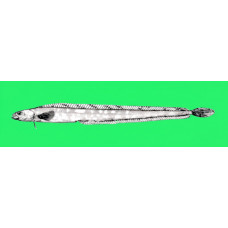Latin name
Lumpenus lampretaeformis
Other name
Blennius gracilis, blennius lampretaeformis, blennius serpentinus, clinus mohrii, clinus nebulosus, lumpenus gracilis.
Identification
The snakeblenny is characterized by its highly elongated body and pointed caudal fin. The proportions of its body parts change significantly with age, becoming lower and more elongated in larger specimens. The head is uniformly rounded with a rounded snout. The horizontal mouth has an upper jaw that is slightly forward of the lower jaw. The lower lip is interrupted in the front and the lower lip lobes are well-developed. The gill membranes are attached to the gill interspace slightly behind the vertical line extending from the posterior margin of the orbit. In adults, the diameter of the eye exceeds the length of the snout.
Features of fish fins
The dorsal fin of the snakeblenny runs almost the entire length of its body. The anterior rays of the dorsal fin are severely shortened and not connected by webbing. The dorsal and anal fins barely extend to the base of the caudal fin. The caudal fin is more pointed than those of other species, especially in males.
Fish colouring
These fish have a pale brown back, bluish sides, and a greenish-yellow belly. Numerous brown spots cover the sides of the body and sometimes merge into oblique bands. There are usually eight to ten larger spots along the midline of the body. The dorsal fin has numerous oblique stripes and the caudal fin has several transverse stripes.
Distribution
It is widespread in the North Atlantic: From Svalbard to the Scandinavian shores, the North Sea, the southern Baltic Sea, the Faroe Islands, Iceland, and the southeastern coast of Greenland. It is also found along the west coast of Greenland and from Labrador and Newfoundland to Massachusetts Bay.
Habitat
This marine demersal fish prefers temperate climates. They live in habitats ranging from 30 to 373 meters deep, usually between 40 and 100 meters deep. They are non-migratory and live in Y-shaped tubes in the mud.
Size
Males of this species reach a maximum length of 50.0 cm.
Behavior
In the Barents Sea, it is found at depths ranging from 30 to 40 meters to 200 meters (usually no deeper than 100 to 120 meters) on muddy substrates. It inhabits areas with temperatures close to zero (between -1.2° and +2.0°) and high salinities (no lower than 34 ‰). It is also found in shallow waters off Svalbard and in some other areas. Off the western shores of Greenland, it has been found at depths of up to 333 meters. In the southern part of its range, it inhabits areas with much higher temperatures than in the north.
The isolated population in the Baltic Sea is likely a remnant of the last ice age, which reached the Baltic Sea during the early salinity stage.
Food and feeding habits
They feed on small crustaceans, bivalves, sea cucumbers, polychaetes, and starfish.
Reproduction
It matures by three years of age and reaches a length of about 20 cm. Its fecundity is 600–1,100 eggs. The pelagic fry, which are 22-24 mm long, are found off the Murman coast in April, off Iceland from April to June, and off the southern coasts of the Scandinavian Peninsula from February to March. They lay their eggs on the seabed at great depths. It is believed that the parents use burrows to care for the eggs.
Fishing
This species is not commercially important.
Relationship with a person
Harmless.
| Classification | |
| Phylum | Chordata |
| Class | Actinopterygii |
| Squad | Perciformes |
| Family | Stichaeidae |
| Genus | Lumpenus |
| Species | L. lampretaeformis |
| Features | |
| Conservation status | Not Evaluated |
| Habitat | Bottom |
| Life span, years | No information |
| Maximum body weight, kg | No information |
| Maximum length, cm | 50 |
| Sailing speed, m/s | No information |
| Threat to people | Edible |
| Way of eating | Planktonophage |
Snakeblenny
Tags: snakeblenny

